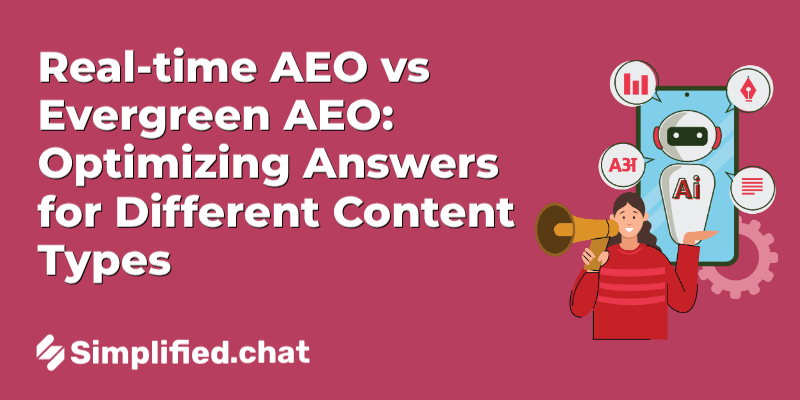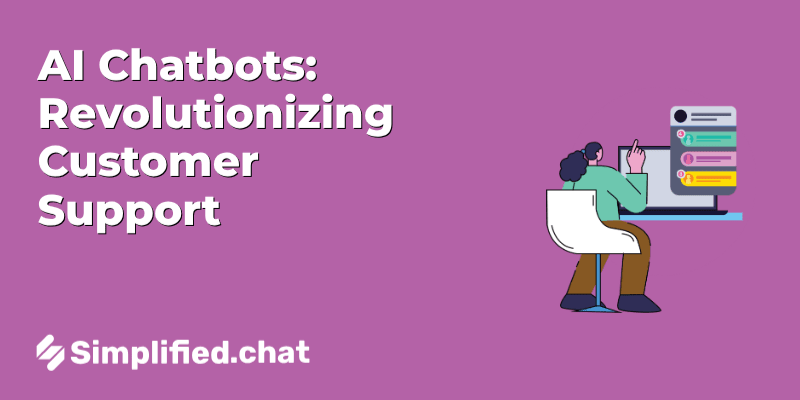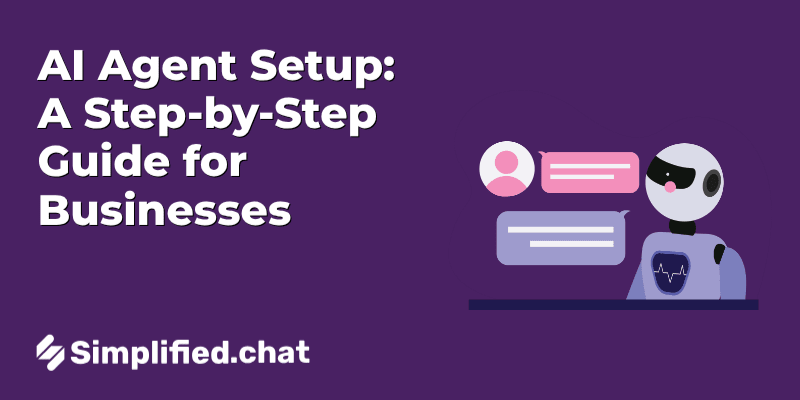Table Of Content
Are you leaving answer engine visibility to chance?
It's time to rethink your Generative Engine Optimization (AEO) strategy. While many focus on traditional SEO, mastering AEO requires understanding how to optimize content based on its lifecycle. You might not know that news content appears in 78% more answer boxes than evergreen content. This blog will explore the differences between real-time and evergreen AEO strategies, helping you tailor your approach for maximum impact. With Simplified AI Workflows, you can automate AEO for every piece of content, ensuring consistent visibility.
As mentioned in the article "Evergreen vs Time-Sensitive Content: Which Is Best for Search Engine Optimization?" by Sandstorm Digital, balancing both evergreen and time-sensitive content strategies is crucial for optimizing visibility in search engines, particularly within the context of Answer Engine Optimization (AEO).
Understanding Real-Time and Evergreen AEO

When optimizing content for Answer Engine Optimization (AEO), recognizing the distinction between real-time and evergreen content is crucial. Each approach serves different user intents, timing needs, and content strategies. Both, however, contribute significantly to capturing valuable search real estate like featured snippets and voice search answers.
What is Real-Time AEO?
Real-Time AEO focuses on content tailored to current, trending topics or immediate search queries. Examples include breaking news, live event coverage, or limited-time promotions. The key to success here lies in delivering fast, accurate, and highly relevant information that aligns with what audiences are searching for "right now."
For instance, a news outlet optimizing an article on a recent election is practicing real-time AEO. This demands agility—content must be produced, published, and updated rapidly to maintain relevance. Search engines favor freshness and precision in these scenarios, so speed takes precedence alongside accuracy.
What is Evergreen AEO?
In contrast, Evergreen AEO revolves around producing content that remains useful, authoritative, and relevant long after publication. These are typically in-depth how-to guides, tutorials, industry knowledge bases, and foundational articles.
Such content aims to satisfy long-tail keyword queries and build lasting authority. For example, a comprehensive guide on “how to set up a home network” will attract searches consistently over time, making it a prime candidate for snippet inclusion and voice search results.
Evergreen content requires thoroughness and clarity, ensuring that it answers questions fully without becoming outdated quickly. Its enduring value helps websites maintain steady organic traffic and a trusted presence in their niche.
The AEO Context
Both real-time and evergreen AEO share a common goal: to secure prominent search features such as answer boxes, featured snippets, and voice search responses. However, their methods and timelines differ significantly. Real-time AEO demands agility and relevance to current events, while evergreen AEO requires comprehensive depth and long-term authority.
Understanding the nuances of each allows marketers and content creators to tailor their strategies effectively. Combining both, when appropriate, can maximize a site’s visibility by capturing immediate attention and sustaining ongoing interest.
Key Differences: Implementation, Resources, and Timeline

Understanding the distinctions between real-time and evergreen SEO strategies helps businesses allocate resources and set realistic expectations. Each approach has unique demands in implementation, resource allocation, and time needed to see results. Let’s break down these aspects to clarify how they differ and when to apply each.
Implementation Difficulty
Real-time SEO optimization requires rapid execution. Since it focuses on trending topics or breaking news, there's little room for prolonged research. Quick content creation and agile publishing become essential to capitalize on fleeting interest.
In contrast, evergreen SEO demands a deeper dive. Content must be carefully researched, thoroughly refined, and designed to remain relevant over time. This often involves comprehensive guides, well-structured articles, or in-depth analyses which require more upfront effort but pay off in longevity.
Resource Requirements
The tools and team capabilities differ significantly between these two strategies:
- Real-time SEO: Relies heavily on monitoring tools that track trending keywords and social media chatter. A responsive content team that can swiftly produce and modify content is crucial.
- Evergreen SEO: Benefits most from access to subject matter experts who can produce authoritative content. Additionally, content optimization software helps maintain and improve rankings over time.
Results Timeline
The timeline to see results mirrors the content nature. Real-time SEO can produce immediate spikes in website traffic shortly after publishing due to capturing current interest. However, this boost may be short-lived if not supported by ongoing updates.
Evergreen SEO builds momentum gradually. Studies show that well-crafted evergreen content steadily attracts organic traffic for months or even years after publication, offering sustainable growth with less volatility.
Best Use Cases
Choosing between real-time and evergreen SEO depends on your goals:
- Real-time SEO: Ideal for brands seeking to capitalize on trending topics, breaking news, or live events where relevancy is fleeting but critical.
- Evergreen SEO: Best suited for establishing authority in your niche and providing long-lasting value through timeless content that addresses ongoing user needs.
By aligning your strategy with these distinctions, you can effectively manage expectations while optimizing for both immediate engagement and long-term visibility.
Crafting a Unified AEO Strategy

Developing a cohesive Answer Engine Optimization (AEO) strategy means balancing immediacy with longevity. To truly engage search engines and users, your content needs to spark initial curiosity while continuing to deliver value over time. This balance is achieved by combining real-time and evergreen content thoughtfully.
Combining Both Approaches
Real-time content captures trending topics and current questions, generating immediate interest and boosting short-term visibility. Evergreen content, on the other hand, serves as a reliable resource that answers broader or recurring queries, contributing to sustainable organic traffic. By strategically integrating these two types of content, you ensure your site appeals to both fleeting trends and long-tail search queries. For example, a timely blog post about a recent industry update can be complemented by in-depth guides that address foundational concepts remaining relevant for months or years.
Step-by-Step Optimization Process
An effective AEO strategy follows a systematic process:
- Identify Target Keywords: Pinpoint keywords focused on questions or conversational phrases that your audience uses, including those suited for featured snippets and voice search.
- Create High-Quality Content: Develop clear, concise answers and well-organized content that directly address user intent, avoiding jargon and complexity.
- Optimize for Answer Engines: Structure content with proper heading tags, bullet points, and schema markup where applicable to increase the chances of capturing featured snippets or voice search results.
- Track Performance: Use analytics to monitor which queries are driving traffic and which content resonates best, refining and updating your approach accordingly.
This iterative process helps maintain relevance and continually improves your site’s visibility in answer engines.
Tools and Techniques
Leveraging the right tools can enhance your AEO efforts significantly:
- Keyword Research Tools: Utilize platforms that specialize in question-based keyword discovery to find topics your audience is actively searching for.
- Content Optimization Platforms: Employ software that analyzes your content’s alignment with search intent and suggests structural improvements for better snippet eligibility.
- AEO-Specific Analytics: Track answer-focused metrics such as featured snippet impressions and voice search rankings to understand what works.
- AI-Powered Tools: Consider incorporating AI-driven solutions like Simplified AI, which can help automate parts of content creation and optimization, ensuring your answers are both timely and high quality without sacrificing efficiency.
By combining these approaches and tools, you can build a resilient AEO strategy that captures immediate interest and sustains performance over time.
Mastering AEO Strategies for Lasting Visibility
Mastering both real-time and evergreen AEO is essential for comprehensive Generative Engine Optimization. By understanding the unique characteristics of each content type and tailoring your strategy accordingly, you can maximize your visibility in answer engines and drive organic growth. Simplified AI Workflows simplifies this process by automating content creation and optimization, allowing you to scale your AEO efforts without expanding your team. Ready to build a sustainable content system? Explore Simplified AI Workflows today and take your content strategy to the next level!
Empower Your Business with Simplified AI Chatbot
Build Your Own AI ChatbotBuild Your First AI Agent Today
Build, train, customize and deploy your first AI chatbot in minutes




